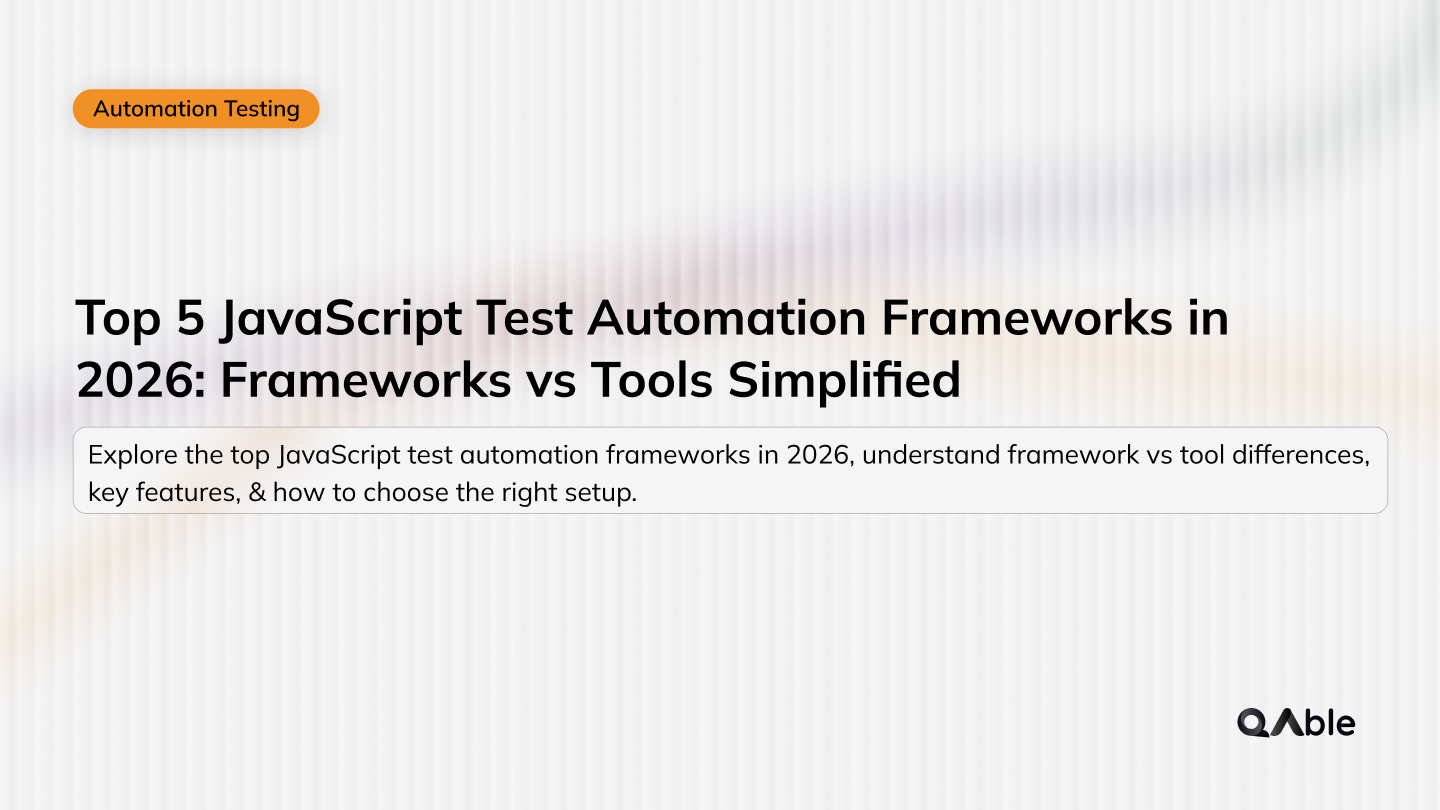Table of content
SHARE THIS ARTICLE
Is this blog hitting the mark?
Contact Us
Software development is not what it used to be years back. The process of developing modern software has transformed to a whole new level.
DevOps is widely used in present-day software development. With the evolution of the development process utilizing agile methods for better and iterative development, software testing companies are embracing the QAOps way of testing software.
Let’s have a better understanding of QAOps and the ways to make your testing process aligned with agile development.
Table of Content
- What is QAOps?
- The Role of QAOps in Software Development
- Benefits of Implementing QAOps
- Best Practices for QAOps
- QAble: Your Ultimate QA Partner for Next-Level Testing with QAOps!
- FAQs
What is QAOps?
QAOps or Quality Assurance Operations is the combination of QA and the techniques from the DevOps methods.
Unlike the traditional QA processes that have been practiced in the software industry for a long time, where QA and testing were implemented at the later phases of software development, QAOps bridges the gap between development and testing.
Agile methodology is widely used in most of the development processes and the traditional methods of QA had difficulties in syncing up with the workflow. This slowed down the development process leading to potential delays in product delivery. QAOps blended the QA testing processes in the agile process leading to better and collaborated workflow with minimum delays.
Also Read: Differences between DevOps and QAOps
The Role of QAOps in Software Development
QAOps aims to deliver quality software without any delays by implementing methods to make Quality Assurance and Testing faster and more reliable with the use of automated tools and smarter methods. Below are some of the things that QAOps bring to the table while developing software:
- Brings QA experts to the team from the start, so they can find and fix problems and bugs quickly.
- Makes sure that the final product has fewer mistakes, so the software quality is better.
- Lets QA professionals work with developers and operations teams, giving feedback and testing all the time.
- QAOps improves productivity by promoting better collaboration between the development and testing teams. Utilizing automated scripts for repetitive testing tasks helps saving valuable time and minimizing human errors.
- It also helps to catch the issues and bugs at earlier stages of SDLC by enabling faster feedback
Benefits of Implementing QAOps
Unlike traditional quality assurance and testing methods in which the testing was performed at later stages of the development cycle, QAOps offers many benefits by syncing up with the development process at all stages of development.
Below are some of the key benefits of QAOps in SDLC:
- Faster Delivery: QAOps lets you test your software as the development goes on. This helps get faster feedback leading to better product quality from the early stages of the development itself. Eventually, the testing process can be performed at faster rates. This helps in releasing new versions or updated versions of the software in an efficient way.
- Better Quality: QAOps makes quality a team effort. The testing you do all the time makes sure that problems are found and fixed early, so your software quality gets better and better.
- More Teamwork: QAOps helps your teams work together better, promoting better collaboration and efficient workflow between development, testing, and operations. This helps your teams communicate, understand, and solve problems better.
- Less Cost: Finding and fixing problems early saves money, because it’s cheaper than fixing them later or when your software is live. Also, the testing you automate in QAOps makes your testing easier, reducing manual work and cost.
- Happier Customers: Good quality software makes your customers happy. By delivering software that works well and has no bugs, QAOps helps you build trust and satisfaction with your users.
Best Practices for QAOps
As discussed previously in this blog about QAOps, we went through the meaning and the benefits of it specifically in software testing as well as in the SDLC as a whole.
In this section, we will go through the best practices that QAOps involves while being integrated into the development process.

Continuous Testing
While we talk about QAOps, what lies at the core of QAOps is the continuous testing part. Like DevOps, where all the components remain isolated and combined as per their requirements or upscaled or downscaled for proper resource allocation in a dynamic workflow, QAOps involves continuous testing to enable early detection of defects and ensure faster feedback to developers.
Below are some of the best practices or methods to conduct continuous testing:
- Test Automation: It involves the usage of automation testing tools such as Selenium and JUnit. These tools and frameworks help in automating repetitive tasks and test cases. These automated tests are combined with the already running CI/CD pipelines. This enables immediate code validations as they change or get modified by the developers.
- Parallel Test Execution: Cloud-based test environments are being used very often in the software development process. QAOps leverages these cloud environments to run tests in parallel. This parallel execution of tests saves a significant amount of time without any delays. This also enables better and more comprehensive test coverage without lagging behind in the development process.
Also Read: Importance of Scalability Testing in Cloud-based SaaS Products
- Continuous Performance Testing: Performance testing is a key method in QAOps using the CI/CD pipeline to ensure that your application can handle different load scenarios. By testing early and often, you can spot and fix performance issues before they affect your users.
Automation
Like the role of automation testing in continuous testing methods, specific automation techniques comprise the fundamentals of QAOps. These techniques not only improve the overall efficiency of the SDLC but also minimizes the chances of human errors.
Below are some of the key automation techniques:
- Automated Test Case Generation: This QAOps automation technique uses model-based or BDD (Behavior Driven Development). Nowadays, these methods have widely been adopted by software testing companies. The software powering these frameworks generates test cases automatically from the business requirements. In short, this approach ensures maximum test coverage while reducing manual effort.
- Infrastructure Automation: Infrastructure automation is the QAOps automation method of turning code into test environments. Utilizing QAOps infrastructure and relevant tools, the testing environments can be configured as per the requirement easily and with accuracy. Infrastructure automation ensures that your testing environments are always consistent and reliable.
- Automated Deployment and Rollback: Automated deployment and rollback help in delivering software without manual intervention or errors. These techniques are used both in DevOps as well as in QAOps for various scenarios. Moreover, you can set up automated rollback mechanisms to undo any deployment failures.
Shift-Left Testing
The shift-left testing methods are widely amalgamated with the QAOps technique. It ensures the integration of testing at earlier stages of SDLC. By moving testing activities to the left side of the development process, the shortcomings or defects can be detected at earlier phases. This helps to reduce costs as well as the defect or bug-fixing efforts ensuring fast and efficient delivery of the product.
Also Read: Need to Test Fast without Compromising Reliability? Better Shift-Left
Below are some of the Shift-Left Testing methods:
- Code Reviews and Peer Programming: Early inclusion of QA experts with the development team through collaborative code reviews and peer programming utilizing QAOps infrastructure and tools helps to get early and continuous feedbacks. This promotes continuous and iterative improvement as the issues and defects are resolved in an efficient manner which results in a better code structure and superior product quality.
- Unit Testing: Encouraging test engineers to write unit tests for their code before integration helps them to validate workflows and address defects at the early stages of the development. This QAOps method helps to validate individual components or functions enabling faster debugging.
- Early Exploratory Testing: QA engineers can perform exploratory testing in the early stages of development to uncover any usability and functionality issues that might affect the user experience. By testing the application utilizing this Shift-Left QAOps method, they can help shape its direction and prevent major defects from occurring later on.
QAble: Your Ultimate QA Partner for Next-Level Testing with QAOps!
QAble is by your side as a leading QA company in India that delivers outstanding software testing services across the globe with state-of-the-art QAOps methods. With QAble, you can expect you product to outperform the competitors in a reliable and more efficient way.
Below are Our QAOps Services:
- Continuous Testing: From unit tests to performance tests, we ensure your software undergoes thorough testing without sacrificing speed with the power of continuous testing with our expertise in integrating automated testing throughout your development lifecycle.
- Test Automation: Benefit from our proficiency in industry-leading test automation tools like Selenium, Appium, and more, to improve your test coverage and reduce time-to-market.
- DevOps-Ready Testing: With QAOps at the heart of our approach, we seamlessly integrate QA into your DevOps pipeline.
- Shift-Left Testing: QAble brings the power of Shift-Left testing to your development process. We catch defects early in the development cycle, reducing rework costs and delivering impeccable software at a faster pace.
- Performance Testing: Rely on our performance testing expertise to optimize your application’s performance under varying loads. QAble ensures your application can handle anything thrown its way.
- Comprehensive Monitoring: Our monitoring solutions empower you to proactively detect and address issues in real time.
Discover More About QA Services
sales@qable.ioDelve deeper into the world of quality assurance (QA) services tailored to your industry needs. Have questions? We're here to listen and provide expert insights


Nishil Patel is the Co-founder of QAble, delivering advanced test automation solutions with a focus on quality and speed. He specializes in modern frameworks like Playwright, Selenium, and Appium, helping teams accelerate testing and ensure flawless application performance.
.svg)














.webp)
.webp)
.png)
.png)











.png)



.png)

.png)

.png)














.jpg)
.jpg)
.jpg)




.webp)

